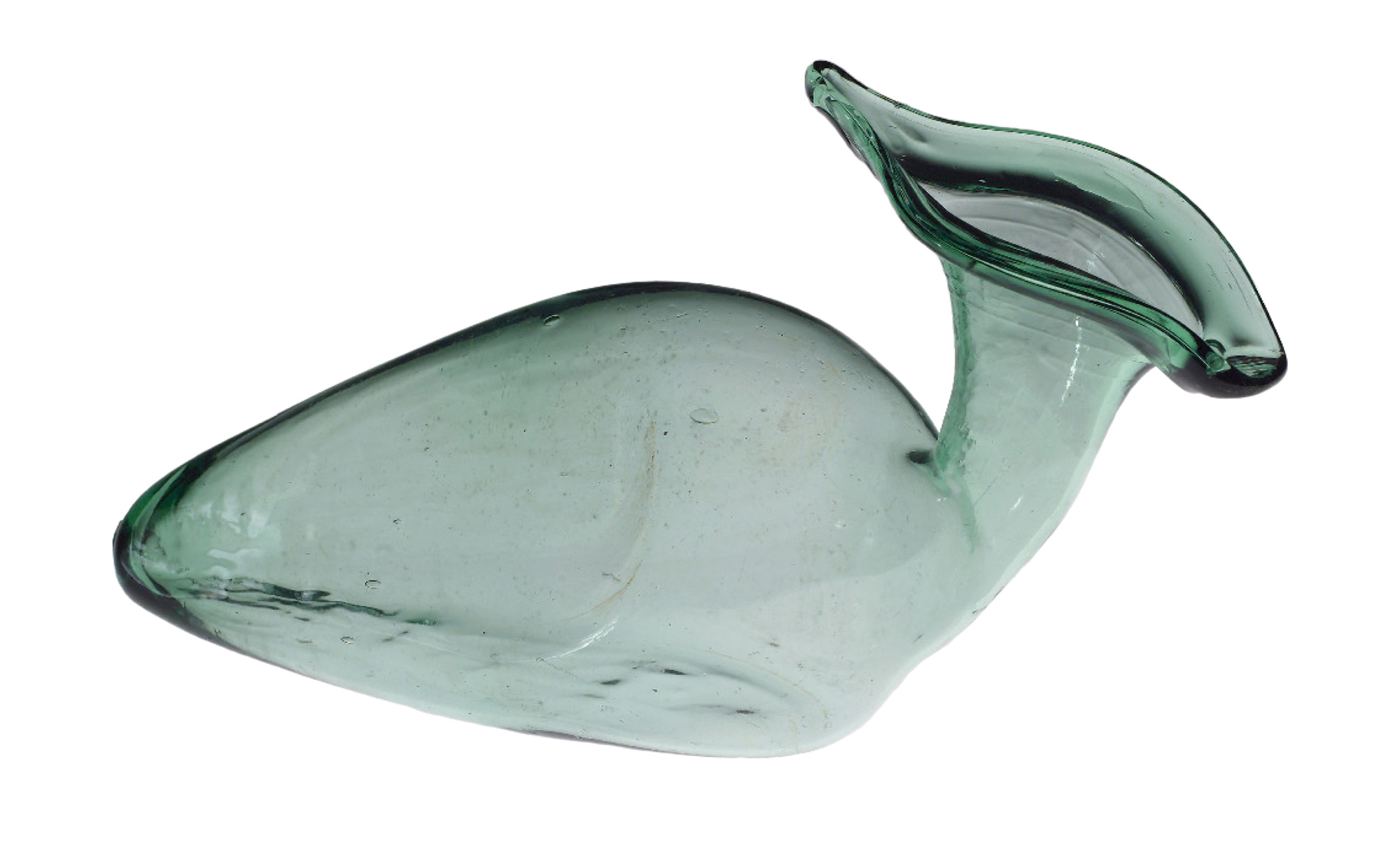Leftovers / A Revolutionary Aim?
Out of the water closet
Barbara Penner
“Leftovers” is a column that investigates the cultural significance of detritus.
Last year at Glastonbury, one of the United Kingdom’s largest music festivals, a radical improvement was introduced: She-Pee, a pink fenced-off enclosure containing urinals for the exclusive use of women (guards stood at the entrance to keep men out). Once inside, intrepid female users were supplied with a P-Mate, effectively a disposable prosthetic penis made of cardboard that enabled them to stand up to pee.
The British media reported widely and positively on She-Pee. And once they figured out how to use P-Mate, the small army of female bloggers at Glastonbury gave it thumbs up too. After explaining how P-Mate worked (place the funnel where your underwear should be, straighten out your knees, point and shoot), one woman concluded, “Okay, it feels a bit weird standing up and it can be a bit tricky when drunk, but otherwise it’s a great invention.” While some hailed She-Pee and P-Mate as a form of empowerment for women, most simply expressed relief at being able to by-pass Glastonbury’s grimy and over-subscribed portaloos.

P-Mate was distributed free at Glastonbury but normally retails for £2.50 ($4.50) for a pack of five. As any woman who does rock-climbing or other adventure sports knows, P-Mate is just one of many cheap and uncelebrated devices available today that allow women to urinate in any situation. (Other popular models include the Whiz and Feminal). These are hardly as progressive as they might initially seem: along with chamber pots and bourdalous, female urinals made of glass or pottery (some remarkably beautiful), have actually been around for centuries, long before water closets were ever invented. Yet Glastonbury 2004 should still be recognized as a milestone of sorts, as it is one of the few attempts in recent times to use such technology to collectively tackle the age-old problem of the queue for the ladies’.
With its ambitious and no-nonsense attitude towards female toilet provision, Glastonbury recalls an earlier but equally innovative festival, London’s Great Exhibition of 1851, where conveniences were provided for the public on a large scale for the first time. Reportedly used 827,820 times over the 141 days of the Exhibition, these toilets, the brainchild of engineer George Jennings, were hailed as a great success and led to an acknowledgement of the “necessity of making similar provisions for the public whenever large numbers are congregated [to alleviate] the sufferings which must be endured by all, but more especially by females on account of the want of them.”
The Great Exhibition could be said to have marked the start of a more civilized era in women’s “elimination facilities” (to borrow the current term in planning parlance). However, it could also be argued that the success of its toilet arrangements actually exacerbated the provision problem for today’s generation of women. The model of the ladies’ room established at the Exhibition—private stalls each provisioned with water closet, lock, and door—is still so dominant that it has not been seriously rethought in the last 150 years. And even though there is a rising recognition of the right to access to public toilets, thanks to campaigns on behalf of groups like the disabled or the transgendered, these discussions have yet to stimulate mainstream debate as to how public toilets are currently designed or how they might be produced in future.
Why should this lack of design innovation matter? For one thing, in the specific case of women, the toilet situation remains dire. There are simply not enough toilets for women in public spaces, even now after nearly two decades of American “potty parity” bills. Publicly acknowledging that its 1984 potty parity legislation has not gone far enough, the New York City Council has recently pushed through a much tougher Women’s Restroom Equity Bill which requires that most new public buildings install two women’s bathrooms for every one men’s (versus the one-to-one ratio which existed previously). The strong support received for this Bill—it was voted in unanimously—suggests that city councilors have largely accepted the arguments of crusaders like John F. Banzhaf III, the “father of potty parity,” who note that women need more water closets because they take longer to pee and because they can’t use urinals.
But is building more female water closets, the main goal of potty parity legislation, the only way to remedy the long line-ups for ladies’ loos? What really stands in the way of women having their own urinals as at Glastonbury?
Since at least the late nineteenth century, there have been a number of small-scale experiments to provide women with such alternate accommodation. In London, circa 1898, “urinettes” were first installed on a trial basis in one female public lavatory. Smaller than conventional water closets, with curtains instead of doors, they were expected to “answer much the same purpose as urinals in the men’s section;” that is, they were to be used for a quick pee. On the face of it, “urinettes” seemed perfectly viable. Not only were they more space-efficient than water closets, but they were also cheap, as only a halfpenny was to be charged for their use instead of the usual penny. Moreover, given that women wore skirts and their underclothing was typically open at the crotch, these devices were probably easier to use then than they would be now.

However, even though they continued to be installed at least into the 1920s, urinettes never appeared to gain widespread acceptance. (I have found only one other reference to them from this period: Florrie, a female patient of Havelock Ellis, refers to a urinette in Portsmouth, the sight of which, she claimed, caused women to flee “in horror.”) Yet the female urinal got another chance when American Standard produced its Sanistand between 1950 and 1973—a fixture which can still occasionally be spotted in national park and zoo restrooms. Advertising for Sanistand made no reference to space-efficiency or cost: rather, it attempted to sell the fixture to women with the promise that they didn’t need “to sit or touch [it] in any way,” playing on fears of contagion and implicitly acknowledging that then, as now, the majority of women prefer to hover when using public toilets.
Even though there is little historical evidence for why these experimental products were discontinued, an explanation is not so hard to find—and this begins to get us to the real problem with rethinking the female toilet. As the horror displayed by the women in Portsmouth reminds us, this behavior is not simply a functional response to female physiology but a cultural product shaped by discourses around the body, privacy, femininity, decency, and hygiene. Women are just as invested in maintaining these discourses as men to the extent that they often override their own physical needs: many women refuse to use a female urinal not on practical grounds but because to use it feels immodest or unnatural or just simply weird.
To balk at such an invention should not be dismissed as mere prudery. Such resistance runs deep, just about as deep as you can go, as many of our toilet attitudes and habits are learned in childhood and, some argue, are fundamental to our gendered sense of self. Simone de Beauvoir, who discussed toilet training in The Second Sex, believed that teaching little girls to squat to urinate constitutes “the most striking sexual differentiation” of their childhood. She explained: “To urinate, [the little girl] is required to crouch, uncover herself, and therefore hide: a shameful and inconvenient procedure.” In society, the erect position is reserved for men alone.
Arguably, then, in order for female urinals to succeed, women must simultaneously be subjected to a complex sort of retraining, one that reverses or subverts the socialization process. This possibility intrigued New York–based architect Yolande Daniels when she began working on her prototype female urinal, FEMME pissoire.
FEMME pissoire consists of a basic ensemble (stainless steel bowl and spout, supply and return hose, mirror, instructional floor mat) that Daniels installed at various locations between 1996 and 1998. Rejecting the “backing on and squatting” stance of most existing female urinals, FEMME pissoire opts for a “standing and facing” position: in other words, it requires women to stand directly over the toilet bowl and to direct the stream of urine themselves as boys are trained to do.
Again, as de Beauvoir observed, whereas boys are taught to control their urine stream through handling their own penis, the girls are taught that their sexual organs are taboo. Daniels’s hope is that, in using FEMME pissoire, women become accustomed to touching themselves to direct the urinary stream until, over time, this gesture becomes “an automatic reflex.” By placing a mirror at eye-level, Daniels also ensures that female users confront images of themselves as they urinate standing up, actively challenging fixed ideas about what is “proper” feminine behavior and fostering an awareness of the learned (as opposed to “natural”) character of the conventions that govern toilet protocol.
Lastly, FEMME pissoire comes with a pair of women’s trousers, the FEMMEp-system pant, which features two zippers: one that opens like a conventional fly, and the other that opens at the crotch. These trousers are an integral part of the redesigned toilet, addressing not only the “pants-round-the-ankle” complaint that repeatedly surfaces with users of female urinals, but also the way in which female genitalia is left unarticulated in clothing design, a “lack,” in comparison to the male. In the same way that the front zipper on trousers articulates male anatomy, the FEMMEp-system pant now articulates and makes visible the female.
Even though Daniels designed FEMME pissoire to be mass-produced, it exists now as a propositional object, a means of challenging the Freudian maxim “anatomy is destiny” and prevailing customs. And despite a new generation of female urinals in production since the 1990s, from the Lady P to the Lady Loo, most of these are purchased for their novelty appeal and installed singly in nightclubs or theaters. The current crop of female urinals is simply too expensive and inflexible to supplant the traditional water closet. And, despite some efforts to train women to pee standing up (see, for instance, “Teaching our Daughters to Pee Standing,” www.restrooms.org/teaching.html [link defunct—Eds.]), most women still require assistance.
Perhaps, ultimately, the best hope for change lies where we began: with inexpensive prosthetic devices like the P-Mate which are portable (most fit comfortably into a purse) and which help women direct their urine stream. While they can be used in conjunction with urinals—and P-Company has recently designed a mobile urinal, the WC3, for use at Glastonbury 2005—they can be easily used anywhere, even out of doors, as well as with any existing toilet facilities. In fact, I would close with a modest proposal: why not have the Whiz or P-Mate machines installed in female public toilets alongside the sanitary pad and condom dispensers, thus saving a generation of women an escape from long lines and dirty seats? Really, in the end, is this aim so revolutionary?
Barbara Penner is a lecturer at the Bartlett School of Architecture, University College London. She is currently co-editing Toilet Papers: the Gendered Construction of Public Toilets.
Spotted an error? Email us at corrections at cabinetmagazine dot org.
If you’ve enjoyed the free articles that we offer on our site, please consider subscribing to our nonprofit magazine. You get twelve online issues and unlimited access to all our archives.